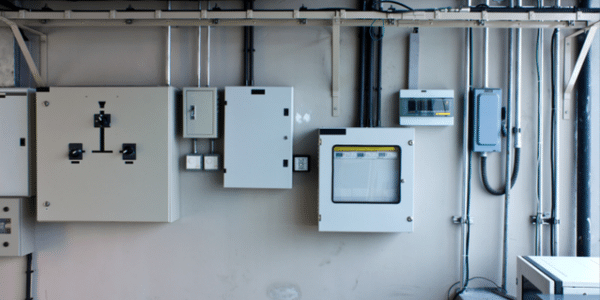Enhancing Safety Standards with Electrical Fiberglass Boxes: What You Need to Know
6/3/20244 min read


Introduction to Electrical Fiberglass Boxes
Electrical fiberglass boxes are enclosures made from reinforced plastic materials, specifically designed to house and protect electrical connections and components. These boxes serve as essential components in various electrical installations, offering a secure and durable housing for wiring, switches, outlets, and other electrical devices. The primary functions of electrical fiberglass boxes include safeguarding electrical connections from environmental hazards, preventing accidental contact, and providing structural support for electrical equipment.
The use of electrical fiberglass boxes has become increasingly prevalent in both residential and commercial settings. They are commonly found in outdoor installations, industrial environments, and areas exposed to harsh conditions. The selection of the appropriate type of electrical box is crucial for ensuring safety and efficiency in electrical systems. Fiberglass boxes, in particular, are favored for their superior durability and resistance to environmental factors, such as moisture, corrosion, and UV radiation.
The evolution of electrical fiberglass boxes dates back several decades. Initially, metal boxes were the standard choice for electrical enclosures due to their strength and conductivity. However, metal boxes presented several challenges, including susceptibility to rust and difficulty in installation. As technology advanced, plastic boxes gained popularity for their lightweight and cost-effective nature. Despite their advantages, plastic boxes often fell short in terms of durability and environmental resistance.
Fiberglass boxes emerged as a solution that combined the best qualities of both metal and plastic. They offer the robustness and longevity of metal while retaining the ease of installation and cost benefits of plastic. Additionally, fiberglass boxes are non-conductive, enhancing safety by reducing the risk of electrical shocks. Their resistance to harsh environmental conditions makes them an ideal choice for outdoor and industrial applications.
In summary, the adoption of electrical fiberglass boxes has significantly improved safety standards in the electrical industry. Their durability, environmental resistance, and ease of installation make them a preferred choice over traditional materials. Understanding the importance of selecting the right type of box for specific electrical installations is essential for optimizing both safety and efficiency.
Safety Benefits of Using Fiberglass Boxes
Fiberglass boxes offer a multitude of safety advantages in electrical applications, making them a preferred choice for many professionals. One of the primary safety benefits is that fiberglass is inherently non-conductive. This characteristic significantly reduces the risk of electrical shock and short circuits, ensuring a higher level of safety for both users and maintenance personnel. In environments where electrical insulation is paramount, fiberglass boxes provide an extra layer of protection that metal or other conductive materials simply cannot match.
Beyond electrical insulation, fiberglass boxes are resistant to corrosion, moisture, and a wide range of chemicals. This resistance makes them particularly suitable for harsh and demanding environments such as industrial sites, coastal areas, and places with high humidity. The longevity of fiberglass boxes in such conditions means that not only are they safer, but they also reduce the need for frequent replacements, thus contributing to overall cost-effectiveness and reliability.
Another critical safety feature of fiberglass is its fire-retardant properties. In the event of an electrical fault, the fire-retardant nature of fiberglass can help prevent the spread of fire, thereby minimizing damage and enhancing safety. This is particularly important in settings where fire safety is a major concern, such as in commercial buildings and residential complexes.
Real-world examples underscore the importance of using fiberglass boxes for enhanced safety. For instance, a case study involving a chemical plant revealed that the switch to fiberglass electrical boxes dramatically reduced the incidence of electrical fires and equipment failures due to corrosive exposure. Similarly, in coastal areas where saltwater corrosion is a persistent issue, fiberglass boxes have demonstrated superior durability and safety compared to their metal counterparts.
Overall, the use of fiberglass boxes in electrical applications is a strategic decision that offers numerous safety benefits. Their non-conductive nature, resistance to harsh environmental factors, and fire-retardant properties collectively contribute to creating safer, more reliable electrical systems.
Best Practices for Installation and Maintenance
Proper installation and maintenance of electrical fiberglass boxes are crucial for ensuring safety and functionality. The first step in installation is selecting the correct size and type of box for your specific needs. Consider the number of wires and devices that will be housed within the box, and ensure it meets all relevant electrical codes and standards. It's essential to choose a box that can securely fit into the intended location, whether it's a wall cavity, a floor panel, or an outdoor setting.
During installation, make sure the electrical fiberglass box is securely mounted. Use appropriate fasteners and support systems to prevent any movement or displacement. Ensure all connections are tight and secure, minimizing the risk of loose connections that could lead to electrical failures or hazards. Following the manufacturer's guidelines and local electrical codes is imperative to achieve a safe and compliant installation.
Routine maintenance is equally important to keep electrical fiberglass boxes in optimal condition. Regularly inspect the boxes for any signs of damage, such as cracks, warping, or discoloration. These issues could indicate exposure to extreme conditions or mechanical stress. Cleaning the boxes periodically to remove dust, dirt, and debris can also help maintain their integrity and performance. Use a soft cloth and mild cleaning agents to avoid causing any damage to the fiberglass material.
Address any signs of wear promptly to prevent potential safety hazards. Replace damaged or worn-out boxes to maintain the overall safety and functionality of your electrical systems. Regular inspections are vital in identifying issues before they escalate, ensuring your setup remains reliable over time.
When troubleshooting common issues related to electrical fiberglass boxes, always prioritize safety. If you encounter problems such as loose fittings, moisture ingress, or electrical malfunctions, it's advisable to consult a professional electrician. They can provide expert advice and solutions to resolve these issues effectively, maintaining the safety and efficiency of your electrical installations.
